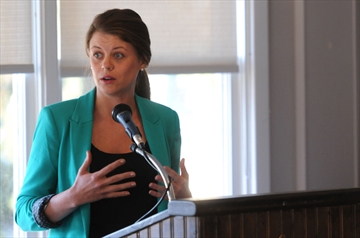On Wednesday morning at the Guelph Golf and Curling Club, the Ontario director of the Canadian Taxpayers Federation spoke in front of a crowd of around 90 people about the fiscal state of the province. She also touched on how Guelph fiscally fared against other municipalities in Ontario.
Last year, the organization released a municipal report card that lined up Guelph against 19 other cities in the province. The report looks at the growth of salaries in municipal governments, focusing specifically on employees who have made the province’s “Sunshine List”, or have an annual salary above $100,000.
Guelph received the second lowest mark of the 20 municipalities on the report card, tying Kingston with a “D”. Oshawa was the only city to score lower, with an “F”. Kitchener scored a “B-“, the second highest on the list.
The report took the number of Guelph city employees who made the Sunshine List in 2012 and the sum of their total salaries, and compared these figures to data collected in 2010. In Guelph, there was an approximate 69 per cent growth in municipal employee salaries on the Sunshine List and a 70 per cent growth in the number of employees on that list.
“Ontario municipalities do not need new revenue tools. They need to be smarter,” she said. Cities must spend their money wisely, especially when it comes to paying employee wages. She said the province is currently $264 billion in debt, and that number is growing. Guelph’s debt is more than $100 million, she said.
The city’s executive director of corporate and human resources Mark Amorosi said the Sunshine List should not be relied upon as an accurate representation of what people are making.
“It is a snapshot at a point in time to capture all and any payments, which include salary, retroactive payments, payments per employment agreements, and so on,” he said. “It’s not an accurate reflection of the growth in the payroll of the city.”
He said in 2010 there were 69 city workers on the Sunshine List. In 2011, that number moved to 93. This increase was due to a change in collective agreements, adding more firefighters to be contracted with the city. In 2012 the number increased to 109, due to a number of sick-bank payouts made because of a change in collective agreements. In 2013 the number jumped to 144 because of further payouts to members of the city’s non-union group.
Amorosi said he expects the number on the list to drop when it comes out again next year, providing there won’t be any unexpected payouts.
In her talk, Malcolm also said property taxes in Guelph are way above the average in the province. The “typical homeowner in Guelph pays more property taxes than any other municipality.”
The report came up with a property tax grading scheme called the “households/fat cat” ratio. It measures how many households — paying the average property tax rate — it would take to pay the salary of the average Sunshine List employee. In Guelph, it would take approximately 29 households. The lower the number of households means the more the average person is paying. Guelph came in 15th place in this matrix.
This June, the federation will put out its second municipal report card using data collected from 2013.


